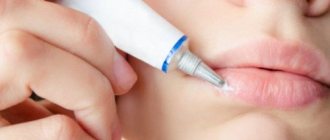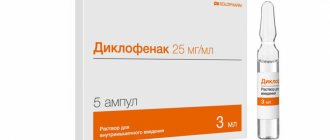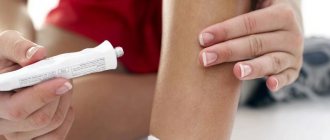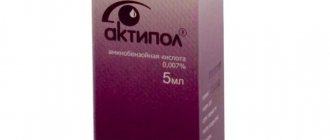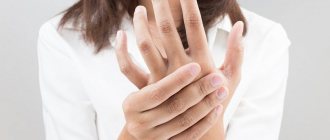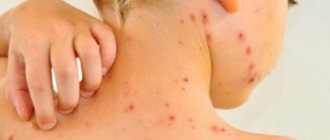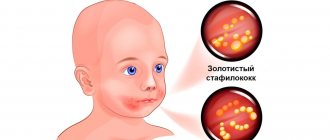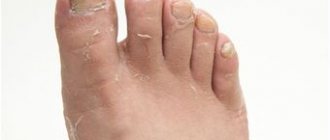Symptoms
The disease manifests itself in the form of spots on the skin.
First, several so-called maternal formations about 5 cm in size appear. Then, over the course of a week, a large number of similar spots of smaller sizes scatter throughout the body. The most vulnerable areas are the abdomen, shoulders and hips. Rashes are rare on the face and neck. All spots, both maternal and “baby” ones, have the same appearance: pink or with a yellowish tint, round in shape, flaky inside with a smooth rim. Often, apart from spots, this disease does not manifest itself in any way. Therefore, as soon as any characteristic formations are discovered on the body, you should immediately contact a special clinic to diagnose pityriasis rosea. Sometimes itching appears in the affected areas, and the lymph nodes on the neck and chin become enlarged. If a person’s immunity is severely weakened, severe fatigue, fever or general intoxication of the whole body appears. There are cases when the external manifestation differs from the usual: blisters or white nodules appear on the skin.
Publications in the media
Pityriasis rosea is an acute dermatosis characterized by abundant, finely scaly pink spots on the trunk, neck and proximal extremities, most often occurring in the autumn-winter period. One of the most common skin diseases; usually resolves spontaneously. Risk factors: infectious diseases, prolonged hypothermia. Frequency. 5% of patients who consulted a dermatologist. It is observed mainly in middle-aged women, rarely in children and the elderly.
Clinical picture • The process begins with a primary maternal plaque, which is much larger in size (2–6 cm) than subsequent rashes, and is often located on the trunk, in the area of the collarbone and shoulder blades. After 7–10 days, sometimes later, many spotted or macular-urticarial elements appear, up to 1–2 cm in diameter, pale pink or slightly brownish in color with pronounced pityriasis-like peeling. The long axes of the spots are located along Langer's lines, indicating the direction of maximum extensibility of the skin • The rashes are localized in the axillary and groin areas, on the inner surface of the thighs and the flexor surface of the forearms. In adults, the skin of the face, scalp, hands and feet, and mucous membranes are usually not affected • Itching is mild or absent altogether • Along with typical manifestations, there are other types of pityriasis rosea •• Urticarial form •• Vesicular form •• Papular form •• Lichen annulare bordered Vidal or pityriasis rosea giant is a rare variant of pityriasis rosea, characterized by single large rashes (up to 8 cm in diameter) of red or pink color with small pityriasis-like peeling along the periphery in the form of a ring, as well as a long course; may occur independently or together with typical rashes.
Test methods • Blood test: slight leukocytosis and eosinophilia • Serological test to rule out syphilis • Skin biopsy: inflammation with cytolytic degeneration of keratinocytes adjacent to Langerhans cells. Differential diagnosis • Toxidermia • Trichophytosis • Syphilitic roseola • Psoriasis • Parapsoriasis • Eczema • Lichen planus • Dermatomycosis of the trunk.
TREATMENT General recommendations • Avoid water treatments, hypothermia • Maintain good hygiene to prevent the development of secondary infection • Diet with limited pickles, spices, marinades, concentrated broths • Insolation • Drug therapy is symptomatic only.
Drug therapy • For an inflammatory reaction and itching - topically: ointments with menthol (0.25–1%) • For very severe itching - prednisolone 10 mg 4 times a day orally until the itching disappears (if discontinued, the dose is reduced gradually) • Antihistamines • Anti-inflammatory drugs (salicylates, indomethacin) • Calcium pantothenate. Complications • With irrational therapy, the development of eczema is possible • Secondary infection. Forecast. Recovery is usually within 4–6 weeks. Very rarely, rashes persist for more than 3 months and, as a rule, are due to irrational therapy. Synonyms • Tinea rosacea Giberta • Giberta disease • Roseola exfoliating
ICD-10 • L42 Pityriasis rosea [Gibera]
Methods of infection
To date, there is no consensus on the methods of infection.
There is an assumption that the source of the disease is the herpes virus and that people with low immunity, those who have recently suffered viral infections, colds, and who are often hypothermic are primarily at risk of contracting Zhiber's disease. Women and children have a significantly higher risk of infection than men. Observations show that people over 40 years of age and infants practically do not become infected with this infection. Is this disease contagious? There is no clear answer to this question. There is an opinion that it can be transmitted through tactile contact or airborne droplets. A prerequisite for a person to become infected is the presence of a provoking factor. In practice, it has been noted that transmission of this virus from one person to another occurs infrequently.
Pityriasis rosea in pregnant women
In pregnant women, pityriasis rosea can develop due to hormonal changes in the body (deficiency of female sex hormones) or a weakening of the immune system due to toxicosis. The disease does not affect the condition of the fetus and does not cause pathologies. However, it is necessary to identify the causes of the disease and eliminate them, since the health of the mother depends on the health of her baby.
The main treatment in such circumstances will be restorative methods. Doctors categorically prohibit the ingestion of decoctions of medicinal herbs, especially St. John's wort, sage, and oregano. Interferons are used to strengthen the immune system, but they should be taken with caution so that your own protective functions do not decrease even further. Multivitamin complexes are often prescribed.
When the disease develops, pregnant women should pay attention to their diet and do special gymnastic exercises. For those who are concerned about itching, doctors recommend treating the rash with vegetable oil, chamomile infusion, and calendula decoction. It is very important to avoid stress, which has an extremely negative effect on the body, including causing pityriasis rosea.
Treatment
Only a qualified specialist can determine what exactly a person has become infected with.
First a visual inspection is carried out. However, this is not enough. This type of disease looks very similar to psoriasis, rubella or syphilitic roseola. To accurately diagnose and prescribe the correct treatment for lichen, the clinic prescribes a blood and urine test, takes a scraping, and the patient undergoes a special test. Gibert's disease does not require particularly complex treatment. The disease goes away in six to nine weeks. The spots gradually fade and stop peeling. For some time, marks remain on the skin, but they also disappear over time. To alleviate the symptoms, the doctor prescribes treatment: to relieve itching - antihistamines, to reduce peeling - various ointments. Multivitamin complexes are also prescribed to increase the patient’s immunity.
In addition to drug treatment of pityriasis rosea, a hypoallergenic diet is prescribed. All foods that can cause allergic reactions are excluded from the diet: citrus fruits, eggs, red fruits, chocolate, coffee, alcohol, honey, nuts.
It is also necessary to exclude physical activity, passing exams, limit communication in order to avoid getting into stressful situations, try to wear clothes made from natural fabrics, and wash only in the shower with mild detergents. It is also forbidden to expose the affected areas of the skin to direct sunlight, as this increases the peeling process and, accordingly, impedes healing. Any self-medication can lead to undesirable consequences, so consultation with a specialist is necessary.
Causes of pityriasis rosea
Currently, the exact cause of the pathology is not clear. Many representatives of the medical community believe that the development of pityriasis rosea occurs under the influence of the herpes virus, but this opinion has not yet been confirmed. It is believed that the disease can be triggered by taking certain medications.
Risk factors also include:
- Decreased immunity due to acute respiratory viral infections, sore throat, colds;
- Presence of chronic diseases;
- Stressful situations;
- Disruptions in the metabolic process;
- Illiterate skin care;
- Allergic manifestations;
- Hypovitaminosis;
- Injuries and damage to the skin, including insect bites.
Pityriasis rosea develops due to hypothermia or as a consequence of vaccination. Sometimes the cause is pathologies of the digestive system.
Make an appointment with a dermatologist by phone or by filling out the online form
| Select a clinic | Skin rash | Dermatologist at the clinic | Dermatologist at home |
How to avoid infection
Due to the fact that the nature of the occurrence of Gibert's disease has not been thoroughly studied, there are no methods to prevent this disease. The main recommendation is to monitor the state of the immune system, as it will help avoid infection.
Complications
The disease itself in most cases goes away without leaving a trace. However, sometimes complications arise in the form of eczema, staphylococcus or streptococcus; ring-shaped lichen can develop, which quite often becomes chronic and even after a few years a relapse can occur. Then treatment is done with antibiotics. To prevent such problems, we strongly recommend that you undergo comprehensive treatment in our clinic. Don't forget about your health and the health of your family!
Pityriasis rosea in children
In childhood, pityriasis rosea manifests itself mainly after acute respiratory viral infection. The scales on the rash are usually sparse or absent altogether. The spots most often form in the inguinal folds and armpits. With this disease, the child can continue to live a normal life, the only limitation concerns water procedures. Do not use washcloths or rub the skin with hard towels. During the period of exacerbation of the disease, excessive sweating should be prevented, so physical activity will have to be limited.
It is important to follow all doctor's recommendations. As a rule, drug treatment is not required, but special attention should be paid to restoring the body's immune defenses. In this regard, a balanced diet, room ventilation, and adherence to general hygiene rules play an important role. If there is itching or an atypical course of the pathology, the doctor prescribes medications. But it is not recommended to use folk remedies.
Prevention of pityriasis rosea
Simple preventive measures can prevent the development of the disease. To protect your body from pityriasis rosea, you need:
- Observe the rules of personal hygiene;
- Avoid synthetic and woolen clothing;
- Carefully select cosmetics, paying attention to their composition, quality, expiration dates;
- Adjust your diet so that your diet contains all the necessary substances;
- Avoid products with artificial colors and additives;
- Forget about bad habits;
- Temper yourself;
- Take vitamins as prescribed by your doctor.
It is advisable not to indulge in strong tea and coffee, fatty and fried foods. At the first manifestations of pityriasis rosea, you need to protect the areas of skin with rashes from direct sunlight and consult a doctor.
Ointments used for pityriasis rosea
For severe, disturbing itching, anti-inflammatory and antiallergic creams and formulations are prescribed. Ointments are used to treat the disease:
- Hydrocortisone – has an anti-inflammatory effect, relieves itching;
- Olettrinovaya is an antibacterial drug;
- Prednisolone - a composition with healing properties that can relieve inflammation;
- Loriden A - ointment with antipruritic, anti-parotid, anti-edematous effects;
- Sinalar – eliminates inflammation due to antibacterial properties;
- Lassara paste is an antiseptic that discolors stains;
- Rioloxol - antibacterial and anti-inflammatory;
- Flucinar – effectively relieves itching, eliminates flaking and inflammation;
- Sulfur – inhibits the inflammatory process.
Tsindol suspension also helps dry the skin, eliminate inflammation and itching. Ointments are applied to the pink plaques in a thin layer in accordance with the instructions and directions of the doctor. The treatment course is 2-3 weeks, the frequency of use of each drug is determined individually. At the same time as using medications, you should be careful with the affected skin.
However, any ointments, like all other medications, should be used exclusively as prescribed by a doctor, so as not to aggravate the situation. In addition, the effectiveness of each of the listed external remedies greatly depends on the patient’s age, the state of his immunity, the degree of spread of lichen, the presence of chronic pathologies and other characteristics of the body.
Diagnosis of pityriasis rosea
Diagnosis of the disease is not difficult, since the manifestations of the pathology are quite typical. But the doctor must make sure that the rash is caused by pityriasis rosea, and not by eczema, syphilis, psoriasis or fungal infection of the skin - mycosis.
In addition, the disease can occur in an atypical form, so special studies and tests are carried out to confirm the diagnosis.
| Appointment with a dermatologist at the clinic. Call a dermatologist at home. | Reception is strictly by appointment, make an appointment by phone: +7 | Prices for services | Reviews about the clinic |
Calling a dermatologist to your home for pityriasis rosea
When the first signs of pityriasis rosea appear, you should consult a doctor. Today there is a convenient service for calling a doctor to your home, which provides many advantages:
- Saving time - no need to go to a medical facility or wait for your turn at the office door. You can simply arrange a doctor’s visit at a time convenient for you;
- Comfort – communicating with a doctor at home is much easier, because the doctor is not distracted by other patients and clinic staff, he can spend as much time as necessary on examination and consultation;
- Calmness – for children of all ages, a visit to a medical facility is often stressful, which plays a negative role in the development of many diseases, including pityriasis rosea. A doctor’s home visit will save the child from unnecessary worries;
- No risk – the development of pityriasis rosea often occurs against the background of weakened immunity. In such circumstances, contact with other patients is undesirable, but it is almost impossible to avoid it in the corridors of the clinic, as well as in public transport on the way to the medical facility. At home, such a risk is eliminated;
- If the disease is accompanied by fever, calling a doctor at home will be the best solution;
- Examination at home is the most convenient option for older people, mothers with small children, and patients with disabilities.
The quality of medical care at home is no different from that provided in a medical facility. The doctor gives the necessary recommendations, provides full consultation, diagnoses the disease and prescribes adequate treatment.
Common symptoms and manipulations in dermatology:
- Skin rashes
- Calling a dermatologist to your home
- Itching in the urethra
- Itchy skin
- Skin rash
- Prevention of casual sex
- Skin neoplasms
- Pyoderma
- Pityriasis rosea
- Streptoderma
- Scabies
- Peeling skin
- Fungal infections
- Skin infection
- Pus on the skin
- Blisters on the skin
- Papillomas on the foreskin
- Sexually transmitted diseases
- Skin structure
